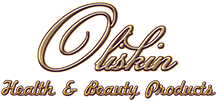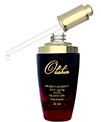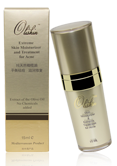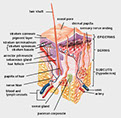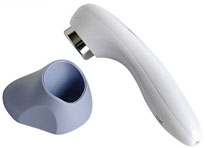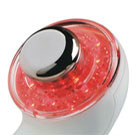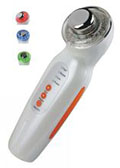Skin Care Products
Frequently Asked Questions

Customer Service
- Customer Service
- Authorized Sales
- Distributors
- Marketing
- Certifications

Acne
Acne steps & Useful Information
What Is Acne?
Acne is a disorder resulting from the action of hormones and other substances on the skin’s oil glands (sebaceous glands) and hair follicles. These factors lead to plugged pores and outbreaks of lesions commonly called pimples or zits. Acne lesions usually occur on the face, neck, back, chest, and  shoulders. Although acne is usually not a serious health threat, it can be a source of significant emotional distress. Severe acne can lead to permanent scarring.
shoulders. Although acne is usually not a serious health threat, it can be a source of significant emotional distress. Severe acne can lead to permanent scarring.
How Does Acne Develop?
Researchers describe acne as a disease of the pilosebaceous units (PSUs). Found over most of the body, pilosebaceous units consist of a sebaceous gland connected to a canal, called a follicle, that contains a fine hair (see illustration “Normal Pilosebaceous”). These units are most numerous on the face, upper back, and chest. The sebaceous glands make an oily substance called sebum that normally empties onto the skin surface through the opening of the follicle, commonly called a pore. Cells called keratinocytes line the follicle.
The hair, 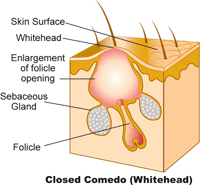 sebum, and keratinocytes that fill the narrow follicle may produce a plug, which is an early sign of acne. The plug prevents sebum from reaching the surface of the skin through a pore. The mixture of oil and cells allows bacteria Propionibacterium acnes (P. acnes) that normally live on the skin to grow in the plugged follicles. These bacteria produce chemicals and enzymes and attract white blood cells that cause inflammation. (Inflammation is a characteristic reaction of tissues to disease or injury and is marked by four signs: swelling, redness, heat, and pain.) When the wall of the plugged follicle breaks down, it spills everything into the nearby skin—sebum, shed skin cells, and bacteria—leading to lesions or pimples.
sebum, and keratinocytes that fill the narrow follicle may produce a plug, which is an early sign of acne. The plug prevents sebum from reaching the surface of the skin through a pore. The mixture of oil and cells allows bacteria Propionibacterium acnes (P. acnes) that normally live on the skin to grow in the plugged follicles. These bacteria produce chemicals and enzymes and attract white blood cells that cause inflammation. (Inflammation is a characteristic reaction of tissues to disease or injury and is marked by four signs: swelling, redness, heat, and pain.) When the wall of the plugged follicle breaks down, it spills everything into the nearby skin—sebum, shed skin cells, and bacteria—leading to lesions or pimples.
People with acne frequently have a variety of lesions, some of which are shown in the illustrations below. The basic acne lesion, called the comedo, is simply an enlarged and plugged hair follicle. If the comedo stays beneath the skin, it is called a closed comedo and produces a white bump called a whitehead. A comedo that reaches the surface of the skin and opens up is called an open comedo or blackhead because it looks black on the skin’s surface. This black discoloration is due to changes in sebum as it is exposed to air. It is not due to dirt. Both whiteheads and blackheads may stay in the skin for a long time.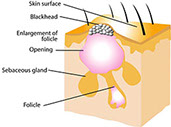
Other troublesome acne lesions can develop, including the following:
- Papules: Inflamed lesions that usually appear as small, pink bumps on the skin and can be tender to the touch.
- Pustules (pimples): Papules topped by white or yellow pus-filled lesions that may be red at the base.
- Nodules: Large, painful, solid lesions that are lodged deep within the skin.
- Cysts: Deep, painful, pus-filled lesions that can cause scarring.
What Causes Acne?
The exact cause of acne is unknown, but researchers believe it results from several related factors. One important factor is an increase in hormones called androgens (male sex hormones). These increase in both boys and girls during puberty and cause the sebaceous glands to enlarge and make more sebum. Hormonal changes related to pregnancy or starting or stopping birth control pills can also cause acne.
Another factor is heredity or genetics. Researchers believe that the tendency to develop acne can be inherited from parents. For example, studies have shown that many school-age boys with acne have a family history of the disorder. Certain drugs, including androgens and lithium, are known to cause acne. Greasy cosmetics may alter the cells of the follicles and make them stick together, producing a plug.
Factors That Can Make Acne Worse
Factors that can cause an acne flare include:
- Changing hormone levels in adolescent girls and adult women 2 to 7 days before their menstrual period starts
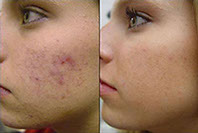
- Oil from skin products (moisturizers or cosmetics) or grease encountered in the work environment (for example, a kitchen with fry vats)
- Pressure from sports helmets or equipment, backpacks, tight collars, or tight sports uniforms
- Environmental irritants, such as pollution and high humidity
- Squeezing or picking at blemishes
- Hard scrubbing of the skin
- Stress.
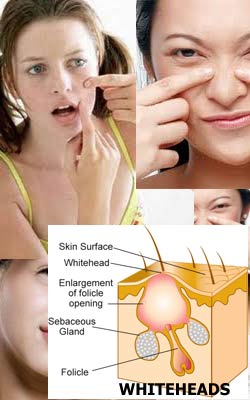 Myths About the Causes of Acne
Myths About the Causes of Acne
There are many myths about what causes acne. Chocolate and greasy foods are often blamed, but there is little evidence that foods have much effect on the development and course of acne in most people. Another common myth is that dirty skin causes acne; however, blackheads and other acne lesions are not caused by dirt. Stress doesn’t cause acne, but research suggests that for people who have acne, stress can make it worse.
Who Gets Acne?
People of all races and ages get acne. It is most common in adolescents and young adults. An estimated 80 percent of all people between the ages of 11 and 30 have acne outbreaks at some point. For most people, acne tends to go away by the time they reach their thirties; however, some people in their forties and fifties continue to have this skin problem.
How Is Acne Treated?
Oliskin has develop a formula based on cold press 100% natural olive oil blended with similar olive oil that has been preserved for over 40 years and come up with an acne cure and gives a 100% result in just 21 days for light acne and a bit longer for severe acne.
The goals of treatment are to heal existing lesions, stop new lesions from forming, prevent scarring, and minimize the psychological stress and embarrassment caused by this disease. Oliskin Olive Oil acne cure (100% natural without any additives or harmful chemicals) is aimed at reducing several problems that play a part in causing acne:
- Abnormal clumping of cells in the follicles
- Increased oil production
- Bacteria
- Inflammation
Treatment for Blackheads, Whiteheads, and Mild Inflammatory Acne
Doctors usually recommend an OTC or prescription topical medicine for people with mild signs of acne. Topical medicine is applied directly to the acne lesions or to the entire area of affected skin.
!!! All medicines can have side effects. Some side effects may be more severe than others. You should review the package insert that comes with your medicine and ask your health care provider or pharmacist if you have any questions about the possible side effects.
Topical OTC medicines are available in many forms, such as gels, lotions, creams, soaps, or pads. In some people, OTC acne medicines may cause side effects such as skin irritation, burning, or redness, which often get better or go away with continued use of the medicine. If you experience severe or prolonged side effects, you should report them to your doctor.
Oliskin's Olive Oil is natural product and has no side effect as it is made from selected 100% cold pressed Olive oil from own plantation in the Mediterranean sea region, it has been used for over 6000 years.
How Should People With Acne Care for Their Skin?
Clean Skin Gently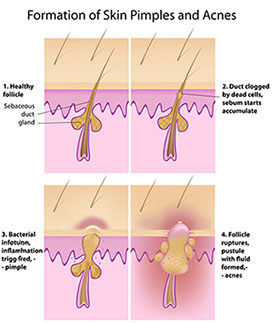
If you have acne, you should gently wash your face with Oliskin's Olive Oil cleanser, once in the morning and once in the evening, as well as after heavy exercise. Wash your face from under the jaw to the hairline and be sure to thoroughly rinse your skin.
Using strong soaps or rough scrub pads is not helpful and can actually make the problem worse. Astringents are not recommended unless the skin is very oily, and then they should be used only on oily spots.
It is also important to shampoo your hair regularly. If you have oily hair, you may want to wash it every day.
Avoid Frequent Handling of the Skin
Avoid rubbing and touching skin lesions. Squeezing, pinching or picking blemishes can lead to the development of scars or dark blotches.
Shave Carefully
Test both electric and safety razors to see which is more comfortable. When using a safety razor, make sure the blade is sharp and soften the hair thoroughly with soap and water before applying shaving cream. Shave gently and only when necessary to reduce the risk of nicking blemishes.
Avoid a Sunburn or Suntan
Many of the medicines used to treat acne can make you more prone to sunburn. A sunburn that reddens the skin or suntan that darkens the skin may make blemishes less visible and make the skin feel drier. However, these benefits are only temporary, and there are known risks of excessive sun exposure, such as more rapid skin aging and a risk of developing skin cancer.
Choose Cosmetics Carefully
While undergoing acne treatment, you may need to change some of the cosmetics you use. All cosmetics and hair-care products should be oil free. Choose products labeled noncomedogenic (meaning they don’t promote the formation of closed pores). In some people, however, even these products may make acne worse.
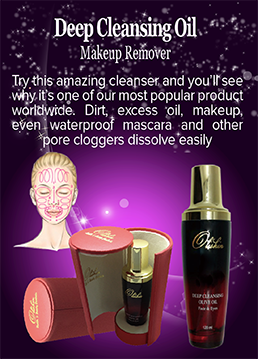 For the first few weeks of treatment, applying foundation evenly may be difficult because the skin may be red or scaly.
For the first few weeks of treatment, applying foundation evenly may be difficult because the skin may be red or scaly.
What Research Is Being Conducted on Acne?
Scientists are also trying to better understand the mechanisms involved in acne so that they can develop new treatments that work on those mechanisms. For example, one group researchers is studying the mechanisms that regulate the development of the sebaceous glands. Another group is trying to understand how P. acnes activates the immune system in order to identify possible immunologic interventions. Other areas of research involve examining the effects of isotretinoin (a potent drug for acne) on the sebaceous glands. Moreover, a new drug called isoprenylcysteine is currently being evaluated for the treatment of P. acnes-induced inflammation and overproduction of sebum.
How to get rid of Acne:
1. Step One: Wash your face
Wash your face twice a day with Oliskin Olive Oil cleansers, which cleanse the skin without drying it.
Gently rub the cleanser into the skin for a few seconds. Work into a full lather and rinse thoroughly and then pat dry.
Never exfoliate the skin if you have cysts or pustules – you can seriously irritate the skin and make the acne worst.
2. Step Two: Reduce the oily secretions
Use Oliskin's specially designed Moisturizers and lotions for acne prone skin. The moisturizers and lotions for Acne speed up skin cell turnover, dry up the oils and promote sloughing of dead skin cells. Apply to the whole face.
Remember:
Overzealous cleansing of the skin can lead to irritation of both normal skin and acne lesions.
If you have pimples it’s essential to use a toner. It is recommend that you use a toner containing alcohol. A tonic containing alcohol will dry them but use it carefully. Use specially designed tonics and lotions for oily and acne prone skin.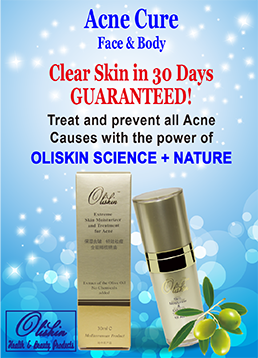
How to protect:
- Remove dirt and makeup residue
- The cleanness is a decisive factor; cleanse your face every day
- Use Oliskin's cleansers that keep your skin clean and reduce the oils
- Make sure your skin is well hydrated
- Always use a sunscreen – it will protect your skin from the UV rays and the appearance of dark spots
- Never use greasy cosmetics
- Never forget to remove the make-up in the evening
- Drink at least 1.5 liter water a day
Tips:
- Avoid squeezing a pimples doing so may cause infection and scarring
- Establish a strict skincare regime to prevent breakouts
- It can take up to a 4 week for a pimple to disappear completely.
- Do a clay mask twice a week to keep your skin clear, it works best for skin that is prone to pimples.
- Squeezing a pimple often leads to infection and scarring.
- Never touch your face with dirty hands.
- Keep yourself hydrated drink at least 1.5 liter water.
- Always use oil-free cosmetics.
- Early treatment is the best way to prevent pimples scars.
- Always remove your makeup and cleanse your face in the evening.
- Avoid using products containing harsh ingredients.
- Avoid applying foundation while there is an acne breakout.
- Keep your makeup brushes clean.
- Throw out old makeup products.
- Always apply moisturizer after washing your face.
- Keep your skin clean and well moisturized all the time.
Squeezing pimples is more likely to make acne
worse as well as leave scars
Back to top ⇧
You may also read:
⇪
Top
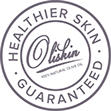
Bringing the Best to Everyone We Touch
and Being the Best in Everything We Do
Receive emails about new products, latest trends, and special offers
© Oliskin 2012 - 2014. All rights reserved. Terms of Use Privacy Policy
